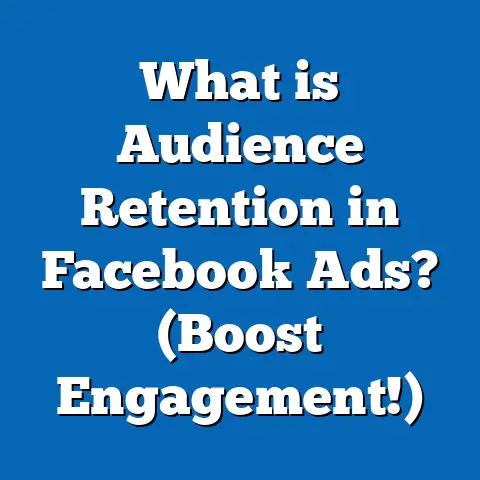What is a Pixel in Facebook Ads? (Unlocking Data Insights)
What is a Pixel in Facebook Ads? (Unlocking Data Insights)
Introduction: The Power of Data-Driven Advertising
Did you know that businesses using Facebook Pixel report up to a 20% increase in conversion rates on average? In the rapidly evolving world of digital marketing, data-driven decisions are no longer optional—they are critical for success. Facebook Pixel has become one of the most important tools for advertisers aiming to maximize the effectiveness of their campaigns. It collects valuable information about how users interact with your website after clicking on your ads, allowing you to track conversions, optimize ad delivery, and build finely targeted audiences.
Understanding Facebook Pixel: The Basics
What is a Facebook Pixel?
Facebook Pixel is a snippet of JavaScript code that you install on your website. This code tracks visitor activity and sends that data back to Facebook. It allows advertisers to understand what actions people take once they’ve clicked on or viewed an ad, such as:
- Viewing content pages
- Adding items to shopping carts
- Initiating checkouts
- Completing purchases or submitting forms
This tracking helps measure the effectiveness of ads and improves targeting accuracy by linking web behavior to Facebook profiles.
How Does Facebook Pixel Work?
When a visitor lands on your website, the Pixel fires and logs the event. It uses cookies and device IDs to associate that activity with a specific Facebook user anonymously.
Facebook then aggregates this data to give you insights like:
- Which ads led to a purchase
- How much time users spent on your site
- Which pages were most engaging
- Where users dropped off in the conversion funnel
By tracking these micro-interactions, Facebook Pixel builds a rich dataset that advertisers can use for optimization.
Key Components of Facebook Pixel
- Base Code: The core snippet that must be placed on every page to track visits.
- Standard Events: Predefined actions such as PageView, AddToCart, Purchase.
- Custom Events: User-defined events tailored for specific business needs.
- Parameters: Additional data points sent with events (e.g., product ID, value).
Why Facebook Pixel is Essential for Advertisers
Detailed Conversion Tracking Improves ROI
One of the biggest challenges marketers face is understanding which ads actually drive results. Facebook Pixel offers precise conversion tracking so you can attribute sales or leads directly back to your campaigns.
- According to Facebook’s own reports, advertisers using Pixel for conversion tracking see an average 15-25% boost in reporting accuracy.
- A 2023 AdEspresso study found that campaigns optimized with Pixel data delivered 30% higher ROAS compared to those without.
This means more efficient budget allocation and better ad performance.
Audience Building and Retargeting: Reaching the Right People
Facebook Pixel enables advanced audience creation by segmenting visitors based on their actions on your site:
- Retarget cart abandoners who didn’t complete checkout.
- Target users who visited specific product pages but didn’t purchase.
- Build lookalike audiences based on high-value customers identified via Pixel data.
These audiences tend to be more engaged and convert at higher rates because they have already shown interest in your offerings.
Optimizing Ad Delivery with Machine Learning
Facebook’s ad algorithm uses Pixel event data to optimize delivery toward users likely to take desired actions.
For example:
- If you run a campaign optimized for purchases, Facebook uses Pixel data to find users with similar behaviors as past buyers.
- Over time, this improves targeting precision and reduces wasted spend.
Setting Up Facebook Pixel: Step-by-Step Guide
Step 1: Create Your Facebook Pixel
- Navigate to Facebook Events Manager.
- Click Connect Data Sources, then select Web.
- Name your Pixel (choose something easy to recognize).
- Enter your website URL for guidance on setup options.
Step 2: Install the Pixel Code on Your Website
You have multiple options:
- Manual Installation: Copy and paste the base code into your website’s header before the closing
</head>tag. - Partner Integrations: Platforms like Shopify, WordPress, Wix, and Squarespace offer built-in apps/plugins for easy setup.
- Google Tag Manager: Add the pixel code as a new tag for centralized management.
Step 3: Verify Your Pixel is Working
Use the Facebook Pixel Helper Chrome extension:
- Visit your website.
- Check if it detects your Pixel and confirms events are firing correctly.
- Events Manager will also show real-time activity.
Step 4: Set Up Standard Events
Add event codes on specific pages or actions:
| Event | Description | Example Use |
|---|---|---|
| PageView | Tracks page loads | Every page |
| ViewContent | Visitor views a product or key page | Product detail page |
| AddToCart | Items added to shopping cart | Cart page |
| InitiateCheckout | Visitor starts checkout process | Checkout page |
| Purchase | Completed purchase | Thank you/confirmation page |
| Lead | User submits a lead form | Contact or signup form |
How Facebook Pixel Unlocks Data Insights
Cross-Device and Cross-Browser Tracking
Facebook’s login-based system enables tracking users even if they switch between devices or browsers. This means:
- Your data reflects true user journeys rather than fragmented sessions.
- You can attribute conversions more accurately across platforms.
Research shows multi-device usage has increased by over 60% since 2018, making this feature crucial.
Offline Conversion Tracking
Facebook allows advertisers to upload offline event data (e.g., in-store purchases, phone orders) which links back to online ad interactions via identifiers like email or phone numbers.
This bridges the gap between online ads and real-world sales, helping marketers understand full ROI.
Advanced Attribution Models Using Pixel Data
Pixel supports different attribution windows (e.g., 1-day click, 7-day click/view). This helps advertisers understand how long after interacting with an ad users convert.
A Nielsen study found that nearly 30% of conversions happen after 7 days post-ad view, highlighting the importance of flexible attribution windows.
Deep Dive into Advanced Facebook Pixel Features
Custom Conversions for Tailored Tracking
Custom conversions allow you to define conversion actions without modifying code by setting URL rules or parameters in Events Manager.
Example:
Track newsletter sign-ups by setting URL contains “thank-you-newsletter” as a conversion event.
This simplifies tracking non-standard goals.
Value Optimization for Revenue Growth
Instead of optimizing just for conversions, you can optimize campaigns based on purchase value using Pixel’s value parameters.
Advertisers using value optimization report:
- 20% higher average order value (AOV)
- Better ROAS since high-value customers are prioritized
Event Deduplication
When events are tracked via both Pixel and Conversions API (server-side), Facebook deduplicates them to avoid double counting.
This ensures accurate reporting across multiple data sources.
Case Studies: Real Results from Facebook Pixel Implementation
Case Study 1: E-commerce Brand Sees 35% Sales Increase
An online fashion retailer integrated Facebook Pixel with detailed event tracking and retargeting campaigns focused on cart abandoners and product viewers.
Results after 3 months:
- Conversion rate increased by 28%
- Return on Ad Spend improved by 35%
- Cart abandonment retargeting cut checkout drop-off by 40%
This boosted revenue significantly without increasing ad budget.
Case Study 2: B2B Lead Generation Firm Boosts Qualified Leads by 50%
A B2B services company used custom events for form submissions and integrated Offline Events to track phone leads linked back to Facebook ads.
Outcomes:
- Lead tracking accuracy doubled
- Qualified leads increased by 50%
- Cost per lead dropped by 20%
Improved data allowed smarter budget allocation and creative testing.
Case Study 3: SaaS Startup Uses Lookalike Audiences for Rapid Growth
A SaaS startup built lookalike audiences based on high-value trial users tracked via Facebook Pixel. Campaigns optimized using this data led to:
- 3x increase in trial signups within two months
- Lower cost per acquisition by 25%
- Better user retention due to quality leads reaching onboarding
Comparing Facebook Pixel with Other Popular Tracking Tools
| Feature | Facebook Pixel | Google Analytics | TikTok Pixel | Snapchat Pixel |
|---|---|---|---|---|
| Integration Focus | Deeply integrated with Facebook Ads | Comprehensive website traffic analysis | Integrated with TikTok Ads platform | Integrated with Snapchat Ads |
| Cross-Device Tracking | Yes, via Facebook login | Limited device linking | Yes, but less developed | Yes |
| Event Tracking | Standard & custom events | Event tracking via tagging | Standard & custom events | Standard & custom events |
| Retargeting Support | Extensive audience building & retargeting | Limited retargeting outside Google Ads | Retargeting within TikTok | Retargeting within Snapchat |
| Offline Conversion | Supported via Offline Events | Limited | Limited | Limited |
| Privacy Adaptations | Supports Aggregated Event Measurement | Enhanced privacy controls | Ongoing privacy updates | Ongoing privacy updates |
Facebook Pixel remains the most powerful for advertisers focused on Facebook properties due to its deep integration and robust features.
Best Practices for Maximizing Facebook Pixel Effectiveness
1. Strategically Plan Events Aligned with Business Goals
Identify which user actions truly matter—whether purchases, leads, signups—and track those specifically.
Avoid over-tracking irrelevant events that dilute data clarity.
2. Regularly Audit Your Pixel Setup
Use tools like:
- Facebook Pixel Helper for browser verification
- Events Manager for performance insights
- Test events feature to simulate conversions
Ensure all critical events fire correctly and no duplication occurs.
3. Combine Pixel with Conversions API for Robust Data Collection
Browser restrictions (e.g., Safari ITP, iOS14+ privacy changes) limit cookie tracking effectiveness.
Server-side tracking via Conversions API sends event data directly from your server to Facebook, improving reliability when combined with Pixel.
4. Leverage Custom Audiences and Lookalikes Based on High-Value Actions
Use detailed event data to build segmented audiences for retargeting and lookalike modeling.
Example audiences:
- Visitors who placed an order over $100
- Users who viewed a product category multiple times
- Abandoned cart visitors within last 7 days
5. Optimize Campaigns Continuously Using Data Insights
Monitor key metrics like CPA, ROAS, conversion rate by audience segment.
Test creatives and placements targeting different custom audiences built from pixel data.
Privacy and Compliance Considerations When Using Facebook Pixel
With increasing user privacy concerns and regulations like GDPR (Europe) and CCPA (California), responsible tracking is essential.
Steps for Compliance:
- Update privacy policies clearly explaining pixel use.
- Implement cookie consent banners allowing opt-in/opt-out.
- Use Aggregated Event Measurement (AEM) for limited but compliant conversion tracking under iOS14+ ATT framework.
- Avoid collecting personally identifiable information (PII) directly through pixel events.
Failing to comply risks legal penalties and damages brand reputation.
Troubleshooting Common Facebook Pixel Issues
- Pixel Not Firing
- Check if code is correctly installed in header section.
- Use Pixel Helper extension for diagnostics.
- Events Not Registering
- Verify event parameters are set properly.
- Confirm no conflicting scripts block execution.
- Duplicate Events
- Review if both pixel and Conversions API send same event without deduplication setup.
- Data Discrepancies Between Ads Manager and Analytics
- Understand that each tool measures differently; Ads Manager attributes via pixel while Analytics uses sessions.
- Delayed Reporting
- Allow up to 24 hours for full conversion reporting due to aggregation delays.
Future Trends Impacting Facebook Pixel and Data Tracking
Increased Emphasis on Server-Side Tracking
With browser restrictions growing stricter, server-side data collection like Conversions API will become standard practice alongside pixel tracking.
AI-Powered Attribution Models
Facebook continues developing machine learning models that predict conversions more accurately even with partial data loss due to privacy controls.
Cross-App & Cross-Web Tracking Expansion
Facebook aims to expand pixel-like capabilities beyond websites into apps and other digital touchpoints for unified measurement.
Greater Transparency & User Control
Users will gain more control over their data with enhanced privacy tools, requiring marketers to adapt tracking methods accordingly.
Summary: Key Takeaways About Facebook Pixel
- Facebook Pixel is a fundamental tool that tracks visitor behavior enabling precise conversion measurement.
- It powers advanced targeting options like retargeting and lookalike audiences.
- Proper setup combined with Conversions API ensures reliable data amid privacy challenges.
- Utilize custom events and value optimization for detailed campaign insights.
- Regular audits prevent tracking errors and improve ROI.
- Compliance with privacy laws is non-negotiable in modern marketing.
Next Steps: Implementing Facebook Pixel Successfully
- If you haven’t installed it yet, create your pixel now in Events Manager.
- Map out key customer actions you want to track (purchase, lead, signup).
- Install base code and event snippets using manual or integration methods.
- Validate installation with diagnostic tools regularly.
- Set up custom audiences based on website interactions.
- Test retargeting campaigns targeting high-intent visitors.
- Combine pixel data with Conversions API for robust tracking.
- Monitor performance metrics closely, optimize campaigns accordingly.
- Stay updated on privacy regulations and adjust consent mechanisms.
- Experiment with value optimization if revenue maximization is priority.
By following these steps, marketers can unlock powerful data insights that transform campaign outcomes from guesswork into predictable growth engines.






